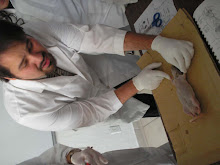Today´s class topic was SYSTEMATICS.
First, we start with Linnaeus (about the 1700s) who divided nature in three kingdoms: Mineralia, Vegetabilia, and Animalia.
-Mineralia for rocks and minerals.
-Vegetabilia for plants.
-Animalia for animals.
Linnaeus developed the binomial system and named every living organism he knew. The names for the genus species have certain characteristics for being a genus:
- They are written in latin, because is a language that hasn´t change over the years such as Spanish or any other language.
- They must be in written on italics.
- The first letter of the two words must be in CAPITAL letters.
- Description: The genus must include the principal characteristic of the organism.
- Example: Homo Sapiens: man that thinks.
Haeckel (about the 1860s) modified the classification by eliminating Mineralia, since they aren´t living organisms, add another kingdom and renamed the other two. So the 3 kingdoms he put in his theory are:
- Protista: unicellular living organisms.
- Plantae: plants.
- Animalis: animals.
Whittaker (in 1959) proposed 5 kingdoms:
- Plantae: Multi-cell and autotroph*.
- Animalia: Multi-cell and heterotroph**.
- Protista (protozoans): Single cell organisms with a mixed feeding.
- Monera (bacterial): Single cell, heterotroph and prokaryotic, making it the only kingdom that has prokaryotic cells.
- Fungi (mushrooms): Multi and unicell and heterotroph. They have cell wall such as plants which make it eukaryotic but it doesn´t undergo photosynthesis.
*Organisms that produce their own energy.
** Organisms that take their energy from others.
Woese (in 1994) and a group of scientists, before named naturalists, raise the Monera kingdom to a higher level. This proposes 3 domains:
- Archaeobacteria and Eubacteria – instead of the Monera kingdom he created two domains (which is a higher level than a kingdom) and they are prokaryotic .
- The third domain is Eukarya in which are included the Animalia, Plantae, Protista and Fungi kingdoms.
They are many branches arising from one domain. The set of all branches is called Hierarchy of Classification:
Domain-Kingdom- Phylum- Class- Order-Family- Genus- Species
Example:
Stephanie Sotelo

No hay comentarios:
Publicar un comentario